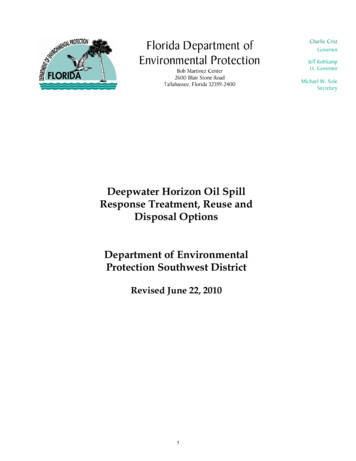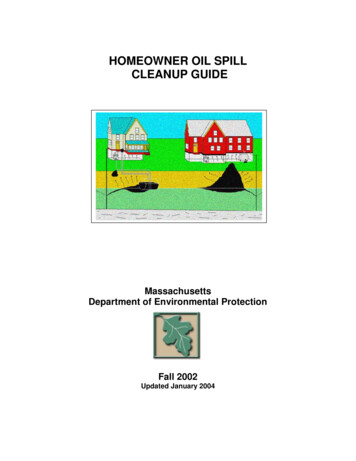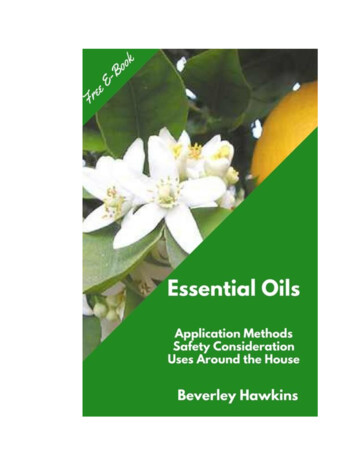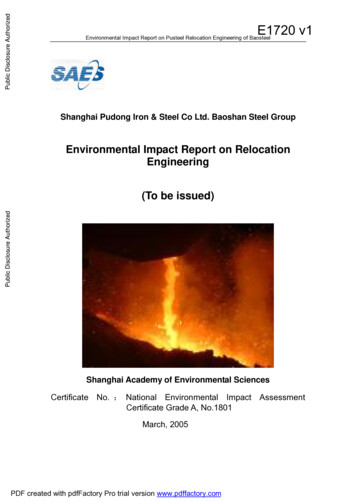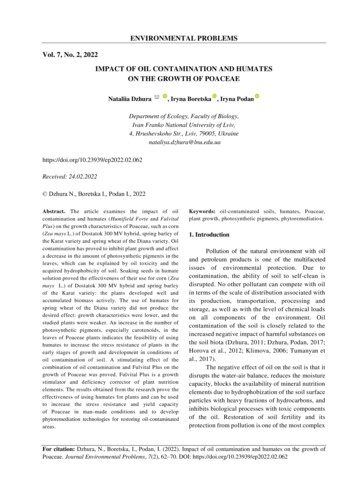
Transcription
ENVIRONMENTAL PROBLEMSVol. 7, No. 2, 2022IMPACT OF OIL CONTAMINATION AND HUMATESON THE GROWTH OF POACEAENataliia Dzhura, Iryna Boretska , Iryna PodanDepartment of Ecology, Faculty of Biology,Ivan Franko National University of Lviv,4, Hrushevskoho Str., Lviv, 79005, 0.23939/ep2022.02.062Received: 24.02.2022 Dzhura N., Boretska I., Podan I., 2022Abstract. The article examines the impact of oilcontamination and humates (Humifield Forte and FulvitalPlus) on the growth characteristics of Poaceae, such as corn(Zea mays L.) of Dostatok 300 MV hybrid, spring barley ofthe Karat variety and spring wheat of the Diana variety. Oilcontamination has proved to inhibit plant growth and affecta decrease in the amount of photosynthetic pigments in theleaves, which can be explained by oil toxicity and theacquired hydrophobicity of soil. Soaking seeds in humatesolution proved the effectiveness of their use for corn (Zeamays L.) of Dostatok 300 MV hybrid and spring barleyof the Karat variety: the plants developed well andaccumulated biomass actively. The use of humates forspring wheat of the Diana variety did not produce thedesired effect: growth characteristics were lower, and thestudied plants were weaker. An increase in the number ofphotosynthetic pigments, especially carotenoids, in theleaves of Poaceae plants indicates the feasibility of usinghumates to increase the stress resistance of plants in theearly stages of growth and development in conditions ofoil contamination of soil. A stimulating effect of thecombination of oil contamination and Fulvital Plus on thegrowth of Poaceae was proved. Fulvital Plus is a growthstimulator and deficiency corrector of plant nutritionelements. The results obtained from the research prove theeffectiveness of using humates for plants and can be usedto increase the stress resistance and yield capacityof Poaceae in man-made conditions and to developphytoremediation technologies for restoring oil-contaminatedareas.Keywords: oil-contaminated soils, humates, Poaceae,plant growth, photosynthetic pigments, phytoremediation.1. IntroductionPollution of the natural environment with oiland petroleum products is one of the multifacetedissues of environmental protection. Due tocontamination, the ability of soil to self-clean isdisrupted. No other pollutant can compete with oilin terms of the scale of distribution associated withits production, transportation, processing andstorage, as well as with the level of chemical loadson all components of the environment. Oilcontamination of the soil is closely related to theincreased negative impact of harmful substances onthe soil biota (Dzhura, 2011; Dzhura, Podan, 2017;Horova et al., 2012; Klimova, 2006; Tumanyan etal., 2017).The negative effect of oil on the soil is that itdisrupts the water-air balance, reduces the moisturecapacity, blocks the availability of mineral nutritionelements due to hydrophobization of the soil surfaceparticles with heavy fractions of hydrocarbons, andinhibits biological processes with toxic componentsof the oil. Restoration of soil fertility and itsprotection from pollution is one of the most complexFor citation: Dzhura, N., Boretska, I., Podan, I. (2022). Impact of oil contamination and humates on the growth ofPoaceae. Journal Environmental Problems, 7(2), 62–70. DOI: https://doi.org/10.23939/ep2022.02.062
Impact of Oil Contamination and Humates on the Growth of Poaceaescientific problems of our time and thus requirestaking a complex of physical, chemical andbiological measures. Research on the participationof plants in the processes of destruction of oilcomponents and development of innovativetechnologies for remediation of contaminated soilsremain relevant and important in both theoreticaland applied aspects (Banks, Schultz, 2005; Dzhura,2011; Gupta et al., 2011).We analyze the issues of phytoremediation ofoil-contaminated areas and possible ways to increasethe stress resistance of plants in man-made conditions.Fertilizers based on humic and fulvic acids which havehigh biological activity and are low in impurities haveappeared in the Ukrainian market. These products arein high demand all over the world and are known asanti-stress agents and growth stimulants, as theyprovide long-term mobilization of the main elementsof mineral nutrition (N, P, K) in the soil and improveits water regime (Danalatos et al., 2007; Horova et al.,2015; Park et al., 2011; Podan, Dzhura, 2019). It isknown that humic products in general and HumifieldForte and Fulvital Plus in particular, aremultifunctional and have bioprotective properties thatensure active growth and development of plants,formation of high yields and high quality of crops, aswell as increase stress resistance to adverseenvironmental conditions (Kim et al., 2012; Matsiuk,2006; Medkov et al., 2017; Stefanovska et al., 2017).Studying the effectiveness of the use of these productsin phytoremediation technologies is of great scientificinterest. Taking into account the topicality of theproblem, we were the first to investigate the effect ofoil contamination of soil and humates on the growth ofPoaceae in order to make further predictions about theeffectiveness of their use for the restoration of oilcontaminated areas through expanding the speciesdiversity by seeds.2. Materials and MethodsThe objects of research were Poaceae plants:corn (Zea mays L.) of Dostatok 300 MV hybrid, springbarley of the Karat variety and spring wheat of theDiana variety, grown in laboratory conditions on oilcontaminated soils under the influence of humates(Humifield Forte and Fulvital Plus). Experiments wereconducted according to the following scheme: No. 1–control (soil without oil) Poaceae plants; No. 2–soil63selected in the vicinity of the oil well on the StaryiSambir oil field in Lviv region (repeatedlycontaminated) Poaceae plants; No. 3 – soil No. 2 oil, 10 g/kg (simulating an oil spill) Poaceaeplants; No. 4–soil No. 2 oil, 10 g/kg Poaceaeplants Humifield Forte; No. 5–soil No. 2 oil,10 g/kg Poaceae plants Fulvital Plus. Twoweeks after oil insertion, seeds were planted. Forvariants 1, 2, 3, seeds were pre-soaked in water andfor variants 4 and 5–in solutions of Humifield Forteand Fulvital plus (0.2 g per 1 litre of water)respectively. Figure 3 shows the studied plants inpots. This scheme applies to all the results of thestudied variants presented in Fig. 1–5.On the 15th and 25th days of vegetation,morphometric parameters and the content ofphotosynthetic pigments in plants were analyzedaccording to the generally accepted methodology.Chlorophyll A and B content and the total amountof carotenoids were quantified in the leaves from asingle sample by the spectrophotometric method(Musiienko et al., 2012). The experiments wererepeated three times. The obtained results wereprocessed statistically. The reliability of thedifference between the control and experimentalvariants was evaluated with Student's t-test, anddifferences where the significance level p was 0.05 were considered as probable.3. Results and DiscussionIt is known that oil contamination of the soilcan change the morphological structure andphysiological activity of plants. The degree ofinhibition of plant growth and development dependson the intensity of contamination, which in turndepends on both oil toxicity and the acquiredhydrophobicity of the soil. Taking into account theindirect impact of oil contamination of soils onplants (water stress, impaired absorption function ofroots, significant lack of nutrients, etc), it can beargued that such conditions are unfavourable forplant growth (Dzhura, Podan, 2017).Growth is one of the most importantparameters that characterizes a plant's response tostress. Research results have shown that Poaceae,such as corn (Zea mays L.) of Dostatok 300 MVhybrid, spring barley of the Karat variety and springwheat of the Diana variety show resistance to oil
64Nataliia Dzhura, Iryna Boretska, Iryna Podancontamination of the soil because even withoutthe use of humates, seeds sprouted, but plantsaccumulated biomass more slowly (Fig. 1, 2, 3,variants 2, 3). For instance, the height of theaboveground part in corn was half that of thecontrol, and in barley and wheat – at the level of thecontrol (Fig. 1, 2, variants 2, 3 as compared tovariant 1).Corn (Zea mays L.) of Dostatok 300 MV hybridSpring barley of the Karat varietySpring wheat of the Diana varietyFig. 1. Impact of oil contamination and humates on Poaceae growth
Impact of Oil Contamination and Humates on the Growth of Poaceae65252015105012345Corn (Zea mays L.) of Dostatok 300 MV hybrid1816141210864201234545Spring barley of the Karat variety2520151050123Spring wheat of the Diana varietyFig. 2. Height of the aboveground part of Poaceae under the effect of oil contamination and humates, cmNo. 1 – control (soil without oil) Poaceae plants;No. 2 – soil selected in the vicinity of the oilwell in the Staryi Sambir oil field in Lviv region(repeatedly contaminated) Poaceae plants;No. 3 – soil No. 2 oil, 10 g/kg (simulating anoil spill) Poaceae plants;No. 4 – soil No. 2 oil, 10 g/kg Poaceae plants Humifield Forte;No. 5 – soil No. 2 oil, 10 g/kg Poaceae plants Fulvital Plus.The use of Humifield Forte (variant 4) andFulvital Plus (variant 5) somewhat stimulated thegrowth and development of corn and barley plants andcontributed to a greater accumulation of biomass, theplants looked more stable and stronger (Fig. 3, variants4, 5, as compared to variants 1, 2, 3).
66Nataliia Dzhura, Iryna Boretska, Iryna PodanSpring barley of the Karat varietyCorn (Zea mays L.) of Dostatok 300 MV hybridFig. 3. Barley and corn plants under the effect of oil contamination and humatesThe experiment showed that spring wheat of theDiana variety proved resistant to oil contamination aswell: seeds sprouted, plants accumulated biomass (seeFig. 1, 2, variants 2, 3), while the use of HumifieldForte (variant 4) and Fulvital Plus (variant 5) did notgive the desired effect: growth parameters were lower,the studied plants were weaker.The direct effect of oil on the vegetation coveris manifested in the fact that plant growth slows down,the functions of photosynthesis and respiration aredisrupted, various morphological disorders can benoted, the root system, leaves, stems and reproductiveorgans suffer. Photosynthetic pigments, especiallychlorophylls, are very sensitive indicators of planthealth. Changes in the content and composition ofpigments under the influence of stress factors arecaused by changes in the ratio of the synthesisintensities and catabolism. At the same time, a numberof scholars note bigger changes in the chlorophyll Acontent as compared to chlorophyll B and explain thisprocess by the lability of the former, which serves as asubstrate for the biosynthesis of the latter. Chlorophyllcontent in leaves is one of the most significantcharacteristics of adaptation of the photosyntheticapparatus of plants to adverse environmentalconditions (Banks, Schultz, 2005; Dzhura, 2011;Dzhura, Podan, 2017).We studied the content of photosyntheticpigments in the leaves of Poaceae plants (Fig. 4, 5).Thus, under the influence of oil, the content ofchlorophylls in the leaves of Z. mays was decreased by30–40 % (see Fig. 4, variants 2, 3 as compared tovariant 1).Obviously, the harmful effect of tarryasphaltene substances of oil on the soil changes itswater-air regime and physicochemical properties,which leads to a deficiency of mineral nutritionelements and a violation of their bioavailability toplants. While the use of Humifield Forte and Fulvitalplus – growth stimulators and deficiency correctorsof plant nutrition elements (variants 4, 5) –contributed to an increase in the content of greenpigments in the leaves of Z. mays, which mayindicate the formation of stress resistance of corn atthe molecular and cellular level.
Impact of Oil Contamination and Humates on the Growth of Poaceae3Chlorophyll AChlorophyll BChlorophyll A BPigmenrs content mg/g2,521,510,5012345Corn (Zea mays L.) of Dostatok 300 MV hybrid1,8Pigmenrs content mg/g1,61,41,210,80,60,40,201234Pigmenrs content mg/gSpring barley of the Karat varietySpring wheat of the Diana varietyFig. 4. Content of photosynthetic pigments in the leaves of Poaceaeunder the effect of oil contamination and humates567
Nataliia Dzhura, Iryna Boretska, Iryna Podan680,6wheatbarleycornPigmenrs content mg/g0,50,40,30,20,1012345Fig. 5. Carotenoid content in the leaves of Poaceae under the effect of oil contamination and humatesIn barley leaves, application of Humifield Fortecontributed to a decrease in the content of greenpigments (variant 4 as compared to variants 2, 3), butthe studied indicators were at the level of control ascompared to variant 1. The reasons for such an effectrequire further explanation and will be explored infuture studies. At the same time, the stimulating effectof joint exposure to oil contamination and Fulvital Plus(variant 5) on the growth and content of photosyntheticpigments in spring barley of the Karat variety wasshown.The experiment showed that the content ofphotosynthetic pigments in the leaves of spring wheatof the Diana variety under the influence of oilcontamination remained almost at the level of control(variants 2, 3 as compared to variant 1). It was provedthat wheat leaves also experienced a stimulating effectof joint exposure to oil contamination and Fulvital Plus(variant 5) on the chlorophyll A content, the totalamount of chlorophylls (A B) and carotenoids (seeFig. 5).Carotenoids are important components of thephotosynthetic apparatus of plants. Not only do theycapture and supply additional light energy to thereaction centres of photosystems I and II, but they alsoprotect the photosystems from the destructive effectsof light and oxygen. As unsaturated hydrocarbons,they contain a significant amount of conjugated doublebonds between carbon atoms, so they can activelyintercept free radicals and inhibit free radical reactions.Carotenoids are polyfunctional pigments that are partsof the multicomponent antioxidant system and areconsidered as one of the factors that ensure thetolerance of plants to various stressful factors(Pidlisnyuk et al., 2016; Turgay et al., 2009).Carotenoids are less sensitive to stress thanchlorophylls. However, when exposed to oil, theircontent in the leaves of the studied plants alsodecreases (see Fig. 5, variants 2, 3). The use ofHumifield Forte and Fulvital Plus (variants 4, 5)contributes to an increase in the carotenoid content,which may indicate an increase in the stress resistanceof the studied plants.Thus, pre-soaking seeds in the solutions of antistress agents (Humifield Forte and Fulvital Plus)increases the resistance of plants, which is manifestedin an increase in the content of photosyntheticpigments, in particular carotenoids, and this confirmsthe feasibility of using humates to increase the stressresistance of plants in the early stages of growth anddevelopment in conditions of oil contamination of thesoil.4. ConclusionsPoaceae, such as corn (Zea mays L.) ofDostatok 300 MV hybrid, spring barley of the Karatvariety, and spring wheat of the Diana variety, are
Impact of Oil Contamination and Humates on the Growth of Poaceaeresistant to oil contamination because even without theuse of humates, seeds sprouted and plants accumulatedbiomass. Oil contamination somewhat inhibited plantgrowth (variants 2, 3), affected the decrease inphotosynthetic pigments content in the leaves due toboth oil toxicity and acquired hydrophobicity of thesoil. Pre-soaking Poaceae seeds in the solutions ofHumifield Forte (variant 4) and Fulvital Plus (variant5) proved the effectiveness of their use for corn andbarley: the plants developed well, accumulated biomassintensively and looked stronger and more stable. Theuse of humates for spring wheat of the Diana varietydid not give the desired effect: growth indicators werelower, the studied plants were weaker (variants 4, 5).The study showed the stimulating effect of jointexposure to oil pollution and Fulvital Plus (variant 5)on the content of carotenoids (variant 5) in the Poaceaeleaves, which indicates the feasibility of using thishumate to increase the stress resistance of plants in theearly stages of growth and development in conditionsof oil contamination of the soil.The obtained research results can be used toincrease the stress resistance and yield of Poaceae inconditions of oil contamination and in the developmentof phytoremediation technologies for the restoration ofoil-contaminated areas.ReferencesBanks, M. K., & Schultz, K. E. (2005). Comparison of plantsfor germination toxicity tests in petroleum-contaminatedsoils. Water, Air, and Soil Pollution, 167 (1-4), 211–219.doi: https://doi.org/10.1007/ s11270-005-8553-4Danalatos, N., Archontoulis, S., & Mitsios, I. (2007). Potentialgrowth and biomass productivity of miscanthus giganteusas affected by plant density and N-fertilization in CentralGreece. Biomass and Bioenergy, 31(2-3), 145–152. doi:https://doi.org/ 10.1016/j.biombioe.2006.07.004Dzhura, N. (2011). Perspektyvy fitoremediatsii naftozabrudnenykhgruntiv roslynamy Faba bona Medic. (Vicia faba L.)[Prospects for phytoremediation of oil-contaminated soilsby Faba bona Medic plants. (Vicia faba L.)]. VisnykLvivskoho Universytetu. Seriia Biolohichna, (57), 117–124.Retrieved from 5/15.pdfDzhura, N., & Podan, I. (2017). Ekolohichni naslidkydovhotryvaloho naftovydobutku na Starosambirskomurodovyshchi [Ecological consequences of extended oilproduction at Staryi Sambir petroleum deposit]. VisnykLvivskoho Universytetu. Seriia Biolohichna, 76, 120–127.Retrieved from 5/15.pdf69Gorova, A., Pavlychenko, A., Kulyna, S. and Shkremetko, O.,(2012). Ecological problems of post-industrial miningareas. Geomechanical Processes During UndergroundMining, 35‒40. doi: https://doi.org/10.1201/b13157Gupta, V. K., Jain, P. K., Gaur, R. K., Lowry, M., Jaroli, D. P.,& Chauhan, U. K. (2011). Bioremediation of petroleum oilcontaminated soil and water. Research Journal ofEnvironmental Toxicology, 5(1), 1–26. doi: https://doi.org/10.3923/rjet.2011.1.26Horova, A., Pavlychenko, A., & Vysochyn, L. (2015 ).Vykorystannia huminovykh rechovyn dlia vidnovlenniagruntiv u hirnychodobuvnykh rehionakh [Use of humicsubstances for soil restoration in mining regions]. IIInternational Scientific and Practical ConferenceRestoration of Biotic Potential of Agroecosystems (pp. 50–51).Dnipropetrovsk; Arbuz.Kim, S., Da, K., & Mei, C. (2012). An efficient system for highquality large-scale micropropagation of miscanthus giganteusplants. In Vitro Cellular & Developmental Biology - Plant,48(6), 613–619. doi: https://doi.org/10.1007/s11627-0129472-xKlimova, N. (2006). Deiaki pytannia metodyky otsinky stanuzabrudnennia gruntiv unaslidok naftohazovydobutku [Somequestions of the methodic of soil pollution state value as aresult of oil and gas mining]. Visnyk LvivskohoUniversytetu. Seriia «Heohrafiia», 33, 144–151. siuk, D. (2006). Ekonomiko-matematychni ta ekolohoenerhetychni aspekty vykorystannia sukhoi biomasy yakalternatyvnoho dzherela enerhii [Economic-mathematicaland ecological-power aspects of dry mass usage asalternative source of energy]. Visnyk VinnytskohoPolitekhnichnoho Instytutu, 5, 111–113. Retrieved ticle/view/348Medkov, A., Stefanovska, T., Pidlisniuk, V., & Ponomarenko, S.(2017). Vplyv rehuliatoriv rostu roslyn na adaptyvnivlastyvosti miskantusu hihantskoho (Miscanthus xgiganteus) dlia vyrobnytstva biomasy na gruntakh,zabrudnenykh vazhkymy metalamy [Impact of plant growthregulators to Miscanthus x giganteus establishment whileproducing biomass at land contaminated by heavy metals].Biolohichni Studii, 11(3-4), 100–101. doi: http://dx.doi.org/10.30970/sbi.1103Musiienko, M., Parshykova, T., & Slavnyi, P. (2001).Spektrofotometrychni metody v praktytsi fiziolohii,biokhimii ta ekolohii roslyn [Spectrophotometric methodsin the practice of physiology, biochemistry and plantecology]. Fitosotsiotsentr, Kyiv.Park, S., Kim, K. S., Kim, J.-T., Kang, D., & Sung, K. (2011).Effects of humic acid on phytodegradation of petroleumhydrocarbons in soil simultaneously contaminated withheavy metals. Journal of Environmental Sciences,23(12), 2034–2041. doi: nyuk, V., Trögl, J., Stefanovska, T., Shapoval, P., &Erickson, L. (2016). Preliminary results on growing secondgeneration biofuel crop miscanthus x giganteus at the
70Nataliia Dzhura, Iryna Boretska, Iryna Podanpolluted military site in Ukraine. Nova Biotechnologica EtChimica, 15(1), 77–84. doi: https://doi.org/10.1515/nbec2016-0008Podan, I. I., & Dzhura, N. M. (2019). Influence of oil pollutionand humates on growth of Miscanthus Plants. EcologicalSciences, 2, 182–186. doi: anovska, T., Pidlisniuk, v, Bilyi, O., Kvak, V., Tsvihun, H.,& Shapoval, P. (2017). Ahronomichni aspekty vyroshchuvanniamiskantusu hihantskoho (Miscanthus xgiganteus) yaksyrovyny dlia vyrobnytstva tverdoho biopalyva nazabrudnenykh vnaslidok viiskovoi diialnosti gruntakh[Agronomic aspects of growing Miscanthus x giganteus asa raw material for the production of solid biofuels on soilscontaminated because of military activity]. BiolohichniStudii, 11(3-4), 99–100. doi: http://dx.doi.org/10.30970/sbi.1103Tumanyan, A., Tyutyuma, N., Bondarenko, A., &Shcherbakova, N. (2017). Influence of Oil Pollution onVarious Types of Soil. Chemistry and Technology of Fuelsand Oils, 53(3), 369–376. doi: http://dx.doi.org/10.1007/s10553-017-0813-7Turgay, O. C., Erdogan, E. E., & Karaca, A. (2009). Effect ofhumic deposit (leonardite) on degradation of semi-volatileand heavy hydrocarbons and soil quality in crude-oilcontaminated soil. Environmental Monitoring andAssessment, 170(1-4), 45–58. doi: https://doi.org/10.1007/s10661-009-1213-1
No. 3 - soil No. 2 oil, 10 g/kg (simulating an oil spill) Poaceae plants; No. 4 - soil No. 2 oil, 10 g/kg Poaceae plants . Barley and corn plants under the effect of oil contamination and humates The experiment showed that spring wheat of the Diana variety proved resistant to oil contamination as well: seeds sprouted, plants .



